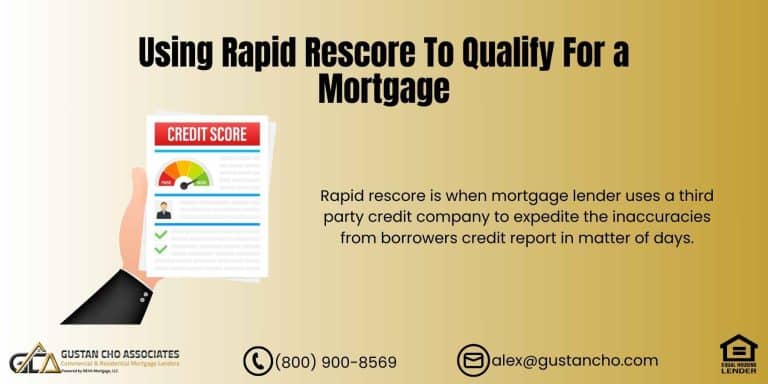Qualifying for a mortgage in 2025 can feel overwhelming, especially with today’s stricter credit models and lender guidelines. But here’s the truth: mortgage approval isn’t about perfection but preparation. By understanding what lenders want to see in a borrower, you can position yourself for success, whether you’re a first-time buyer or re-entering the market after credit challenges.
At Gustan Cho Associates, we help clients nationwide qualify for home loans—even those denied elsewhere—because we follow standard agency guidelines with no lender overlays. Let’s break down exactly what lenders look for when approving a mortgage in 2025.
The Mortgage Approval Checklist in 2025
Every loan application differs, but mortgage lenders always look at the same core factors. Here’s what lenders want to see in a borrower before giving the green light.
Want Fast Mortgage Approval? Here’s What Lenders Look For
Get approved faster by knowing what lenders want to see in your application.
Credit Score and History
Credit is one of the first things underwriters evaluate. A strong credit profile shows you have a history of borrowing and repaying responsibly.
What lenders want to see in a borrower’s credit report:
- A FICO score that meets the program minimums (580 FHA, 620 Conventional, 640+ for some Non-QM).
- On-time payment history for at least the past 12–24 months.
- A mix of credit accounts (installment loans, revolving credit, auto loans).
- No recent collections, charge-offs, or judgments.
2025 update: FICO 10T and VantageScore 4.0 models weigh recent behavior more heavily. That means even small late payments can hurt more, but positive trends like paying down credit cards are rewarded quickly.
Case Example:
Maria had a 610 credit score due to late payments in 2021. Over the past 18 months, she paid every bill on time, reduced her credit utilization from 90% to 30%, and opened a secured credit card. When she applied in 2025, the lender saw strong progress—exactly what lenders want to see in a borrower after setbacks.
Income and Employment Stability
Lenders want proof of steady income. A high-paying job isn’t enough if it looks unstable.
What lenders want to see in a borrower’s income:
- At least two years of verifiable work history.
- Consistency in the same field, even if jobs change.
- Steady or increasing income year over year.
- For self-employed borrowers: 2 years of tax returns—or 12–24 months of business bank statements for Non-QM loans.
2025 trend: Gig economy income, side hustles, and part-time jobs are more widely accepted if well-documented.
Case Example:
James drives for Uber and delivers for DoorDash part-time, but he’s been consistently earning over $2,500/month for two years. With bank statement proof, his income counted—showing that what lenders want to see in a borrower isn’t just W2s but documented, reliable earnings.
Debt-to-Income Ratio (DTI)
The Debt-to-Income (DTI) ratio shows how much of your income goes toward paying off debts, which is super important for lenders to know. You can go as high as 56.9% for FHA loans if you have solid backup reasons. With conventional loans, the limit is usually lower, around 50%. There’s more wiggle room for VA and USDA loans, but keeping your DTI between 41% and 45% is a good idea.
If your DTI is high, underwriters want other strengths like high credit scores, large reserves, or long rental history.
Case Example:
Anthony had a 55% back-end DTI. This is normally risky, but because he had a 720 credit score, $20,000 in savings, and a 10% down payment, he was approved. That’s what lenders want to see in a borrower with a high DTI—compensating factors that reduce risk.
Assets, Down Payment, and Reserves
Lenders closely examine a borrower’s financial situation, focusing on their assets, particularly the down payment and savings. The down payment shows that the borrower is committed to the investment. Different loan types have different requirements—FHA loans need at least 3.5%. In contrast, VA and USDA loans can skip the down payment, and conventional loans usually ask for around 3%. On top of that, lenders like to see that borrowers have 1 to 2 months’ worth of savings set aside after closing, which adds to their sense of financial stability.
It’s also super important for borrowers to prove where their money is coming from. This means no big, unexplained deposits in their accounts. Being straightforward about this helps lenders better understand how a borrower is doing financially and whether they can manage the mortgage.
Case Example:
Sarah had just enough for a 3.5% FHA down payment. She also showed she had $5,000 left in savings to strengthen her application. That reserve reassured the underwriter because lenders want to see a financial cushion in a borrower.
Rental or Housing History
Past behavior predicts future reliability.
What lenders want to see in a borrower’s rental history:
- 12 months of on-time rent payments.
- Cancelled checks, bank transfers, or verification of rent from a property manager.
- Private landlord verification may be acceptable if well-documented.
Warning: Paying cash to your landlord without receipts usually won’t count.
Bank Account Health
Bank statements provide clear information about a person’s financial situation. They show if someone has problems with overdrafts or if their account balances fluctuate. Lenders prefer to see no overdrafts in the past year and want to easily track the money for a down payment, such as through paychecks or bank transfers. They are also careful about sudden large cash deposits without explanation, as this raises questions about the source of the money.
Want a Fast Mortgage Approval? Here’s What You Need to Know
Understand the key factors that make lenders approve your mortgage faster.
What Lenders Want to See in a Borrower With Bad Credit
Having bad credit doesn’t necessarily lead to an automatic denial for loans. Lenders often look for signs of recovery in borrowers with a troubled credit history. Key indicators they expect include a consistent record of no late payments following a bankruptcy or foreclosure, new credit accounts that are being maintained in good standing, and at least 12 months of clean credit history.
Additionally, demonstrating active efforts to rebuild credit, such as through the use of secured credit cards or credit-builder loans, can further strengthen a borrower’s position in the eyes of lenders.
For example, David filed for Chapter 7 bankruptcy in 2021. By 2023, he had two secured credit cards and a car loan with a spotless payment history. In 2025, lenders saw progress and approved him for an FHA loan.
Compensating Factors That Strengthen Your Case
Sometimes one weakness can be offset by another strength.
What lenders want to see in a borrower with risk factors:
- High credit scores offset high DTI.
- Large down payment offsets lower income.
- Extra reserves offset limited work history.
- Long-term employment offsets borderline credit.
Tip: If you’re weak in one area, strengthen another before applying.
Common Mistakes That Hurt Approval
Even strong borrowers can trip up. Avoid these:
- Large undocumented deposits in bank accounts.
- Applying for new credit cards before closing.
- Job changes within 30 days of applying.
- Multiple overdrafts within 12 months.
What lenders want to see in a borrower is consistency—not last-minute financial surprises.
Recent Mortgage Lending Changes in 2025
The lending landscape evolves each year.
- Credit scoring: New models weigh recent payment patterns.
- Gig income: More acceptable, but requires documentation.
- Alternative verification: Automated systems speed up approvals by electronically pulling income and asset data.
- Buy Now, Pay Later accounts: Now reported on credit reports and factored into scores.
Why Work With Gustan Cho Associates
Most lenders add overlays—extra rules beyond FHA, VA, USDA, or Conventional guidelines. At Gustan Cho Associates, we don’t.
That means:
- More approvals for borrowers with high DTI or bad credit.
- Faster closings—sometimes in under 30 days.
- Loan officers are available 7 days a week, evenings, weekends, and holidays.
When other lenders say “no,” we often say “yes.”
Ready to Take the Next Step?
If you want expert help understanding what lenders want to see in a borrower and how you can qualify, please contact Gustan Cho Associates at 800-900-8569, text us for a faster response, or email us at alex@gustancho.com. The team at Gustan Cho Associates is available 7 days a week, on evenings, weekends, and holidays.
Conclusion
At the end of the day, what lenders want to see in a borrower is stability, responsibility, and proof that you can manage a mortgage. Whether through strong credit, consistent income, or compensating factors, presenting a complete financial picture helps you get approved faster.
At Gustan Cho Associates, we specialize in helping borrowers who don’t fit the perfect mold. With no overlays and flexible guidelines, we often approve loans that others can’t.
Who can help me get approved fast?
Gustan Cho Associates specializes in quick, no-overlay approvals nationwide.
Frequently Asked Questions About What Lenders Want to See in A Borrower:
Q: What Lenders Want to See in a Borrower Before Giving a Loan?
A: Lenders want to see stable income, a good credit history, low debt, and proof that you can repay the mortgage on time.
Q: Can I Get a Mortgage with Bad Credit?
A: Yes! What lenders want to see in a borrower with bad credit is a strong reason for past issues and proof that you’re now paying everything on time.
Q: Do Lenders Care About Job Changes?
A: Yes, but what lenders want to see in a borrower is steady work in the same field, even if you’ve changed jobs.
Q: How Important is Rental History for a Mortgage?
A: Very! What lenders want to see in a borrower is on-time rent payments. They show that you’re ready for a mortgage.
5. Will a Past Bankruptcy Stop Me from Getting a Loan?
A: Not always. Lenders want to see re-established credit and no new late payments from a borrower after bankruptcy.
Q: What if My Debt-to-Income Ratio is High?
A: That’s okay if you have other strong factors. What lenders want to see in a borrower with high DTI is good credit, savings, and job stability.
Q: Do I Need a Big Down Payment?
A: No. What lenders want to see in a borrower is that you have some money saved and can afford monthly payments, even with a low down payment.
Q: Can I Use Gig or Self-Employed Income?
A: Yes! In 2025, what lenders want to see in a borrower includes proof of steady gig or self-employed income through bank statements or deposits.
Q: Will Bank Overdrafts Hurt My Chances?
A: Yes. What lenders want to see in a borrower is a clean banking record with no overdrafts in the past 12 months.
Q: What if I Were Denied by Another Lender?
A: Don’t give up. What lenders want to see in a borrower can vary. At Gustan Cho Associates, we approve loans others turn down.
This blog about “What Lenders Want to See in a Borrower for Fast Approval” was updated on September 8th, 2025.
Increase Your Odds of Fast Mortgage Approval
From credit scores to financial stability, learn what lenders are looking for in borrowers.










remodeling of a commercial bldg which i own bldg & property. Revitalize to it’s former entity, which was a carry out hot dog & other food business. Have the architect & contractor ready to go. The title is free & clear and available for collateral